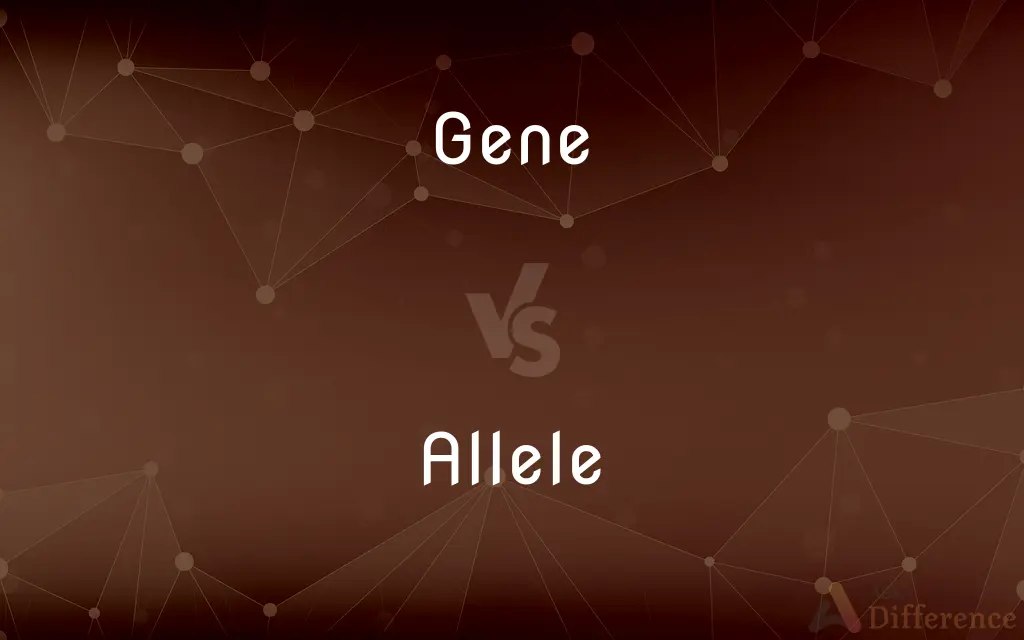Gene vs. Allele — What's the Difference?
Edited by Tayyaba Rehman — By Urooj Arif — Updated on May 15, 2024
Gene refers to a segment of DNA encoding functional products; allele is a variant form of a gene affecting the trait's expression.

Difference Between Gene and Allele
Table of Contents
ADVERTISEMENT
Key Differences
A gene is a sequence of DNA that contains the instructions for building a specific protein or RNA molecule. These instructions are essential for an organism's development and functioning. Whereas an allele represents one of the multiple alternative forms of a gene, each leading to a different phenotype or trait expression. This distinction is fundamental to understanding genetics.
Genes are located on chromosomes and play a crucial role in hereditary processes, determining the genetic traits passed from parents to offspring. On the other hand, alleles contribute to the genetic diversity within a population by introducing variations in the phenotypes of those traits. For example, the gene for eye color has several alleles, resulting in the variation in eye color among humans.
The functioning of a gene is determined by its nucleotide sequence, which guides the synthesis of proteins or RNA molecules that perform specific functions in the body. In contrast, different alleles of a gene differ slightly in their nucleotide sequences, influencing the efficiency or type of protein produced, thereby affecting the organism's phenotype.
In inheritance, each individual typically inherits two alleles for each gene, one from each parent. This results in combinations that can be homozygous (two identical alleles) or heterozygous (two different alleles), impacting the gene's expression. While alleles can be dominant or recessive, determining the trait's visibility in heterozygous combinations.
Understanding the relationship between genes and alleles is crucial for fields like genetics and evolutionary biology, as it explains how traits are passed and how they evolve over time. Variations in alleles can lead to differences in traits that may provide evolutionary advantages or disadvantages.
ADVERTISEMENT
Comparison Chart
Definition
Segment of DNA coding for a protein or RNA.
One of several forms of a specific gene.
Role in Genetics
Determines a specific genetic function.
Determines variations of a genetic trait.
Expression
Consistent within an organism.
Can vary, leading to different phenotypes.
Inheritance Pattern
Passed from parent to offspring.
Two alleles for each gene, one from each parent.
Example
Gene for blood type.
A, B, O alleles for the blood type gene.
Compare with Definitions
Gene
Encoded with instructions for protein synthesis.
The gene for insulin regulates the synthesis of insulin protein.
Allele
A specific version of a gene.
The brown-eye allele alters pigment production in the iris.
Gene
Basis for traits' inheritance.
Genes inherited from both parents determine a child’s eye color.
Allele
Influences phenotype.
The allele for blue eyes results in the absence of brown melanin.
Gene
Found on chromosomes.
The cystic fibrosis gene is located on chromosome 7.
Allele
Contributing factor to genetic diversity.
Different alleles in a population contribute to varied physical features.
Gene
A unit of hereditary information in DNA.
The gene for height can influence how tall a person will grow.
Allele
Can be dominant or recessive.
In pea plants, the tall allele is dominant over the short allele.
Gene
Influences cell function and structure.
Structural genes control the production of physical traits.
Allele
Part of the gene-allele relationship.
Multiple alleles for a single gene can exist in a population.
Gene
In biology, a gene (from genos (Greek) meaning generation or birth or gender) is a basic unit of heredity and a sequence of nucleotides in DNA or RNA that encodes the synthesis of a gene product, either RNA or protein.During gene expression, the DNA is first copied into RNA. The RNA can be directly functional or be the intermediate template for a protein that performs a function. The transmission of genes to an organism's offspring is the basis of the inheritance of phenotypic traits.
Allele
An allele (UK: , ; US: ; modern formation from Greek ἄλλος állos, "other") is one of two, or more, forms of a given gene variant. For example, the ABO blood grouping is controlled by the ABO gene, which has six common alleles.
Gene
(in informal use) a unit of heredity which is transferred from a parent to offspring and is held to determine some characteristic of the offspring
Playing tennis is in my genes
Allele
Any of the alternative forms of a gene or other homologous DNA sequence. Also called allelomorph.
Gene
A hereditary unit consisting of a sequence of DNA that occupies a specific location on a chromosome and is transcribed into an RNA molecule that may function directly or be translated into an amino acid chain. Genes undergo mutation when their DNA sequences change.
Allele
(genetics) One of a number of alternative forms of the same gene occupying a given position, or locus, on a chromosome.
Gene
(genetics) A theoretical unit of heredity of living organisms; a gene may take several values and in principle predetermines a precise trait of an organism's form (phenotype), such as hair color.
Allele
One of two or more alternative forms of a gene that can have the same place on homologous chromosomes and are responsible for alternative traits.
Gene
(molecular biology) A segment of DNA or RNA from a cell's or an organism's genome, that may take several forms and thus parameterizes a phenomenon, in general the structure of a protein; locus.
A change in a gene is reflected in the protein or RNA molecule that it codes for.
Allele
Either of a pair of Mendelian characters that may occur in an organism as a consequence of variation at one gene locus.
Gene
(genetics) a segment of DNA that is involved in producing a polypeptide chain; it can include regions preceding and following the coding DNA as well as introns between the exons; it is considered a unit of heredity;
Genes were formerly called factors
Allele
One of two alternate forms of a gene that can have the same locus on homologous chromosomes and are responsible for alternative traits;
Some alleles are dominant over others
Common Curiosities
What is a gene?
A gene is a section of DNA that encodes information for building proteins or RNA molecules, fundamental for organismal functions.
Can alleles affect a person’s health?
Yes, certain alleles can be associated with diseases or increased health risks, depending on whether they are dominant or recessive.
What is a dominant allele?
A dominant allele is one whose trait always appears in the organism when the allele is present.
What is an allele?
An allele is a variant form of a gene that leads to different expressions of a trait.
What is homozygous?
Homozygous refers to having two identical alleles for a specific gene.
How do genes and alleles relate to each other?
A gene can have multiple alleles, which are different versions of that gene causing variations in the phenotype.
How are alleles inherited?
Each parent contributes one allele for each gene, which combine to determine traits.
What is a recessive allele?
A recessive allele expresses its trait only when two copies of it are present (homozygous).
Why are alleles important in genetics?
Alleles contribute to the diversity within a population, influencing evolution and adaptation.
What is an example of a gene with multiple alleles?
The blood type gene, which has A, B, and O alleles.
How do genes affect phenotype?
Genes determine physical and functional traits by directing protein synthesis.
What role do genes and alleles play in evolution?
They are fundamental in genetic variation, which drives evolutionary changes through natural selection.
What is heterozygous?
Heterozygous refers to having two different alleles for a specific gene.
How does allele frequency change in a population?
Allele frequencies can change due to factors like mutation, selection, and genetic drift.
Can the environment influence gene expression?
Yes, environmental factors can affect how genes are expressed in an individual.
Share Your Discovery

Previous Comparison
Zero vs. Nothing
Next Comparison
Application vs. AppletAuthor Spotlight
Written by
Urooj ArifUrooj is a skilled content writer at Ask Difference, known for her exceptional ability to simplify complex topics into engaging and informative content. With a passion for research and a flair for clear, concise writing, she consistently delivers articles that resonate with our diverse audience.
Edited by
Tayyaba RehmanTayyaba Rehman is a distinguished writer, currently serving as a primary contributor to askdifference.com. As a researcher in semantics and etymology, Tayyaba's passion for the complexity of languages and their distinctions has found a perfect home on the platform. Tayyaba delves into the intricacies of language, distinguishing between commonly confused words and phrases, thereby providing clarity for readers worldwide.
















































